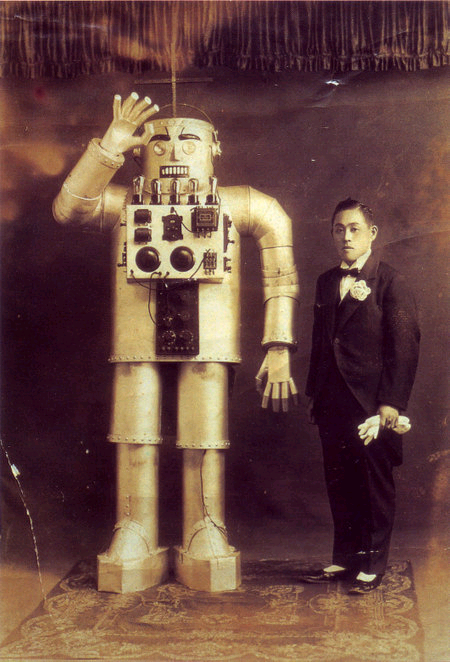
It appears as if Yasutaro Mitsui's Steel Humanoid robot is the first known Japanese robot in humanoid form. With the post author not being able to read nor write in Japanese, it makes it difficult to research.
The image also appears in Haruki Inoue's 1993 book Nihon Robotto Soseiki 1920-1938.
I suspect the electrical devices and valves are for show only, showing the early and lasting influence of Wensley's Televox images already. This idea of exposed electronics and works was to remain a feature of Japanese robots in particular, and heavily influenced to design of most Japanese toy robots. I have an interest in Japanese Karakuri as well (maybe subject to an addiional category at a much later time) . Karakuri ningyo can mean both mechanical and trick puppet. Indeed, the element of trickery or illusion is essential to the performance of karakuri ningyo. For some forms of karakuri, the element of trickery is carried even further for at the front of the performance area may be seen a mechanical device called a zenmai. Zenmai's look like clockwork mechanisms, with wooden gear wheels and a governing fly. It appears as if the zenmai is controlling the movements, and not the other way around. This trickery also equates to the Von Kempelen chess machine by which the display of a complex mechanism appears to be controlling the contrivance.
When one looks at Mitsui's robot in detail, it doesn't appear to be very animated at all. There are no wheels on the feet, and the geometry of the legs suggest it does not walk. There are some apparent wear marks near the top of the legs near the torso, suggesting maybe a bowing action, which is quite probable being Japanese. The fingers are rigid, the neck is rigid. Only the arms appear as if they allow an upward movement by the shoulder and a rotation of the lower arm at the elbow. There appears to be a power cord running up its left leg.